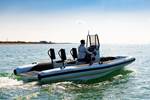Emirates Team New Zealand, Southern Spars partner to beat wind-powered land speed record
Auckland-based sailing team returns with the carbon fiber composite specialist to produce a land yacht light enough to beat the competition.

Photo Credit: Southern Spars
Emirates Team New Zealand, a sailing team based in Auckland, has announced that it is returning to partner with composite specialists Southern Spars NZ (Auckland, New Zealand) in an attempt to beat the wind-powered land speed record of 202.9 kilometers/hour set in 2009 by Richard Jenkins onboard his Greenbird in the U.S.
“Emirates Team New Zealand approached us and asked if we would come on board to build the wing on the land yacht,” Mark Hauser, Southern Spars co-founder recalls. “This is a huge credit to our team, their experience and expertise. It’s an interesting project for us to get our teeth into — we jumped at the chance to be involved.”
With a long history as the go-to partner for Emirates Team New Zealand, Southern Spars says it has built a reputation as being the best in the world at designing and manufacturing carbon fiber spars and rigging. After being in business for more than thirty years, the company claims that it thrives on making the seemingly impossible, possible.

Long-time Emirates Team New Zealand member Glenn Ashby, who will be in the driving seat, says the record attempt is fulfilling a boyhood dream and that he needed to have absolute confidence in the team involved: “To beat a world record you need to work with the best in the world. I’ve never once heard Southern Spars say we can’t do that — it’s always let’s make it happen,” Ashby says.
With production already under way at Southern Spars headquarters in Avondale, the team is on track for completion in the next three to four weeks. The different components of the land yacht will then be brought together and shipped to Australia for the record attempt which will likely take place in August on one of Australia’s salt lakes.
Related Content
-
Plant tour: Teijin Carbon America Inc., Greenwood, S.C., U.S.
In 2018, Teijin broke ground on a facility that is reportedly the largest capacity carbon fiber line currently in existence. The line has been fully functional for nearly two years and has plenty of room for expansion.
-
PEEK vs. PEKK vs. PAEK and continuous compression molding
Suppliers of thermoplastics and carbon fiber chime in regarding PEEK vs. PEKK, and now PAEK, as well as in-situ consolidation — the supply chain for thermoplastic tape composites continues to evolve.
-
The lessons behind OceanGate
Carbon fiber composites faced much criticism in the wake of the OceanGate submersible accident. CW’s publisher Jeff Sloan explains that it’s not that simple.















